When I am asked about adequate remote working space, I usually need clarification: physical or mental space? Because both are equally important to me. Physical space can be prepared, controlled and maintained. While the mental space, headspace as we tend to call it – requires developing new habits. Even with those new habits, we can still face challenges and interruptions. Especially when working from our home – that in itself can be a challenge and a distraction.
Let’s start with the physical space. I would love to know what works for you. I don’t think there is one solution for everyone, but there are some important considerations here:
- Health – this means a good sitting arrangement. I prefer a simple wooden chair which allows me to work but is not too comfortable, so I do get up every hour to stretch. Even if you work from an armchair or your bed – sometimes it’s nice to change things and make the most of more comfortable areas of the house. You will need a good source of light, if possible natural too. You will also need access to water, preferably some plants (I even have fish tanks in my office). And all your essential tools and stationery are within reach too.
- Keeping it simple, keep it tidy – not many people like to tidy up their spaces, so why not keep it simple and minimal instead? I like to have very few things on my desk. All my stationery is in my drawer together with a table cleaning cloth. I can use it quickly when I start the day and get on with work. I really do not like cleaning, so I am doing my best to keep the desk tidy and simply put things away. If you have a pile of books or papers and no time to go through it all now, just move it all elsewhere and keep your working space tidy this way. In the current lockdown situation, we will have plenty of time to get through all our stuff in our free time anyway.
- Inspiration and attention – the space needs to be clear of distractions and motivating to get us more focused too. It’s a question of trial and error, but just sit down, look around and as you start your work, notice what bothers you and what can be improved.
When people ask me about my mental working space, I refer to a mental state which is very similar to how I feel at my desk, only that it really does not depend on that one particular space in the house. It’s a state of calm, steady focus on the task at hand with a sense of lightness and “can-do” positive intent. It takes practice. Once you set up your physical working space, you can try and take the mental state associated with it elsewhere. So bring your working mode and intent to the back garden, kitchen table or the attic. When we work from the office, you might even want to take it there or to the local cafe. Don’t associate it with specific spaces or devices. Move between your mobile phone and laptop too. Practice transitioning from and into that state back again. Once practised and achieved through intense self-discipline and reflection, this private working headspace can be very liberating. You don’t need to carry it with you all the time – so you can switch this state on and off when needed and move to free time much faster too.
Working from home has many new challenges that, for me personally, came as a surprise, so I thought I would share them as working or something to address sooner than later:
- Cleaning – tidying and cleaning the house can be a perfect distraction. When I try to think of a new creative idea and notice an unwashed mug, I am very tempted to go and sort it out. But that means I then have to transition into creative thinking again. To address this challenge, we have two choices: learn to ignore the mess or prevent it. You can, of course, pay someone else to clean your house, but you will still have to keep it tidy. It was not easy at all for me to learn to be orderly and keep my home clean, but like anything else, with a bit of positive attitude, this as well can be learned. And actually learning it made me realise that we do not teach children cleaning yet expect them to be tidy. So I studied minimalism, cleaning and work-friendly interior design. I learned to let go of some stuff but welcomed the additional free space and time to think. I re-designed the house to be an office and a family-friendly home. We all benefited from easier access to everything and a much faster weekend cleaning process. We all learned to put things away and now do not have to stress about them. Keeping our home tidy was initially a way of supporting my business, but it also became a beautiful way for all of us to respect each other.
- Dedicated workspaces for all of us – this meant letting go of some furniture and investing in new desks, lamps, and chairs, but it was worth it. All three of us have now a space to work effectively. We are all different, we have unique needs, so we each have our own desk. We had to let go of some comfort, but the time we gain through faster and more productive work is merely precious.
- Keeping activities in dedicated areas – kitchen for cooking, living room for eating, family time and entertainment and work for upstairs bedrooms in the day time. It’s actually a very effective way of using all the space in the house. And since we all like to be a bit lazy, not spilling drinks on the carpet in the bedrooms saves the cleaning time too. We do have snacks and drinks now and again, but we manage those carefully.
- Saying bye to the clutter – physical clutter means mental clutter, so just get rid of it. We have this thing with boxes – I like metal tins, so those now go to my allotment shed. My boys love some larger packaging boxes, so those go to the attic. We put everything away to enjoy the living and working spaces in the house. Relatively empty desks, tables and shelves mean less cleaning and a lot of mental space too.
- Hacking daily routine – this might seem irrelevant at first, but we have also designed the space to get stuff done faster during the day. Simple household hacks can make all the difference. For example – using a shop wrack to hang out the wet washing on hangers and then on the wrack means that I do not have to fold clothes. I had to get used to our bedroom looking a bit like a clothing department, but actually, this means I need to put stuff away with one move into the cupboards. Deciding not to match son’s socks and string them in one space was simply revolutionary – the act of school rebellion but also an act of liberation from a tedious task.
Now, I do understand that all of this for some of us might sound utterly dull, too structured and a bit of a nuisance, really. I thought it was also. Until I found myself unable to work, getting too distracted and too bogged down with simple tasks around the house. It was tough to learn it all and figure it out. I was feeling pretty helpless at some point. Since I do not like to feel this way, things needed to change. I only wish I had those tips back then.
Today we all share the responsibility of improving the space around us and making it work for us, not vice versa. It can actually be quite relaxing to connect with our living and working spaces. Now, after years of learning this, reflecting on it and implementing those new habits, I can see the benefits. I feel more relaxed. I get more work done and enjoy more see free and family time. I even – although not always – consider the weekend house cleaning a form of my little active mindfulness. I like my working space, and I enjoy watching my family re-connect with theirs when they do it too.
As we all transition into remote work, why not take a moment to re-think our relationship with our home. We are ever so lucky to have it. It keeps us safe. By staying at home, we keep others safe. But we can also learn it and enjoy it even more.
(I would love to hear what works for you or what bothers you. Ask me questions. Share your tips.)
Photo by Andrea Davis on Unsplash

